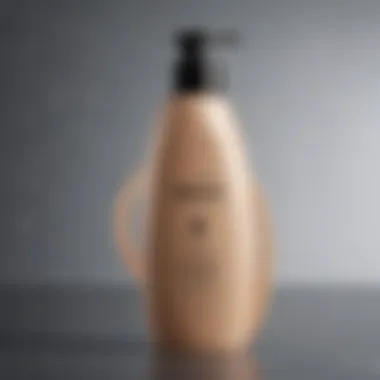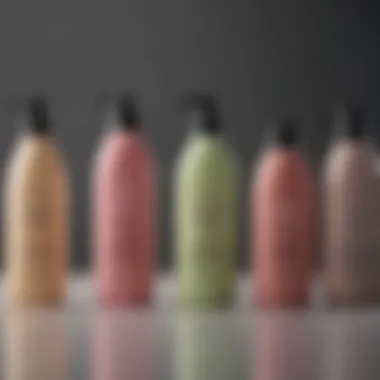Conditioner for Very Dry Damaged Hair: Insights & Tips


Intro
Selecting the right conditioner for very dry, damaged hair is no simple task. The complexity arises from the unique needs of different hair types and the myriad of products available on the market. Understanding how hair sustains damage plays an essential role in making informed choices. Various factors contribute to hair damage, such as environmental influences, heat styling, chemical treatments, and even diet. Because of these issues, moisture loss and brittleness often result, leading to a requirement for specialized conditioning solutions.
The goal of this article is to offer a comprehensive guide aimed at empowering readers with knowledge. By exploring key ingredients, application techniques, and the science behind conditioning, readers can find products that best suit their hair’s condition. Expert opinions, along with scrutinized evaluations of available products, will provide insight into navigating this often-overwhelming landscape. This ensures an educated approach towards achieving healthier, more manageable hair.
In the following sections, we will look into essential components of effective conditioners and examine various formulations. With this information, individuals can tailor their choices based on their unique hair challenges. Ultimately, our insights aim to dismantle common misconceptions in hair care and ensure that knowledgeable decisions are made.
Understanding Very Dry Damaged Hair
Understanding very dry damaged hair is crucial in managing hair health. This section provides insights into the complexities surrounding hair condition, ultimately guiding readers in selecting the right conditioner tailored to their needs. Knowledge of hair damage lays the foundation for making informed choices in hair care. It helps in recognizing the specific elements and common issues that every person might face with their hair. Readers benefit from understanding the root causes, key signs of damage, and the importance of a suitable care routine.
Defining Very Dry Damaged Hair
Very dry damaged hair can be defined as hair that lacks moisture, leading to a loss of natural sheen and becoming prone to breakage. The condition is characterized by dry, coarse strands that often feel rough to the touch. When hair takes on a damaged state, it can stop holding moisture efficiently. This deterioration can arise from multiple factors, making it necessary to address the condition promptly.
Common Causes of Hair Damage
Understanding the common causes of hair damage is essential for prevention and effective treatment. Several factors contribute to the condition of very dry damaged hair:
Environmental Factors
Environmental factors play a significant role in degrading hair health. Exposure to harsh weather conditions, such as sun, wind, and coldness, leads to faster moisture loss. The UV rays from the sun can break down the protein structure of the hair, rendering it more fragile. Pollution also adds an extra layer of stress, as chemical pollutants can lead to further dryness and irritation of the scalp. Eliminating or minimizing exposure to these elements is key in maintaining healthy hair.
Chemical Treatments
Chemical treatments are widespread in hair care but can be detrimental if done incorrectly or too frequently. Processes such as coloring, perming, or straightening involve harsh chemicals that often strip moisture from hair strands. Over time, these treatments compromise the integrity of the hair, making it susceptible to damage and breakage. For those investing in chemical treatments, understanding the balance between desired aesthetics and hair health is critical.
Heat Styling Tools
Heat styling tools, including blow dryers, curling irons, and flat irons, are popular for achieving desired hairstyles but can cause significant damage. Excessive heat can lead to dryness, brittleness, and brittleness, further exacerbating the condition of the hair. It is essential to use these tools sparingly and with appropriate heat protection products to mitigate negative effects.
Improper Hair Care Routines
Improper hair care routines can hinder hair's ability to retain moisture. Neglecting regular conditioning, failing to use suitable products, or being too aggressive when combing can lead to a downward spiral in hair health. Establishing a consistent hair care regimen is vital for maintaining healthy hair. Tailoring routines to individual needs and avoiding over-washing are fundamental for healthy, hydrated hair.
Signs of Damage
Recognizing the signs of damage early can help in taking preventative steps to care for very dry damaged hair. The following indicators should be monitored closely:
Brittleness
Brittleness is a key sign of damaged hair. Hair that breaks easily lacks moisture and elasticity, which indicates a need for immediate intervention. This condition experiences physical breakage that may lead to other issues like split ends, creating a need for stronger conditioning treatments.
Excessive Frizz
Excessive frizz often signals a lack of moisture and a weak hair structure. Dry, frizzy hair appears disheveled and can be challenging to style. This is usually caused by environmental factors, over-processing, and the absence of moisture. Effective conditioners should be sought out to combat this specific issue.
Split Ends
Split ends occur when the hair shaft splits, signifying serious damage. This characteristic not only affects aesthetics but also contributes to overall hair weakness, leading to further damage up the hair shaft. Split ends require attention and can often be resolved through nourishing conditioners and regular trims to maintain hair health.
Understanding these aspects of very dry damaged hair sets the stage for selecting appropriate conditioners and tailoring maintenance routines.
The Role of Conditioners in Hair Care
Conditioners play a vital role in maintaining the health and appearance of hair, especially for individuals dealing with very dry and damaged hair. They serve to restore moisture, improve texture, and enhance manageability. In a world full of hair care products, conditioners can often be overlooked, yet they are essential in a comprehensive hair care routine. Understanding the importance of conditioning can lead to better hair health and a more attractive appearance.


What is a Conditioner?
A conditioner is a hair care product designed to improve the texture, appearance, and health of hair. It typically contains various hydrating agents, oils, and sometimes proteins that help to replenish moisture and reduce damage. When someone applies conditioner after shampooing, it works by coating the hair shaft, smoothing it, and minimizing friction. This results in easier styling and fewer tangles. In essence, conditioner acts as a protective barrier, which is particularly useful for very dry, damaged hair, making it feel softer and more manageable.
Importance of Conditioning Damaged Hair
Conditioning is crucial for damaged hair, as regular shampoos can strip away natural oils. Without adequate conditioning, hair can become brittle, frizzy, and more prone to breakage. Conditioners replenish lost moisture, providing essential nutrients that hair may lack. For those with very dry hair, conditioning helps to restore balance, improve elasticity, and reduce further damage.
In summary, conditioning is not just a luxury; it is a necessity for maintaining healthy hair, ensuring that it looks and feels its best and minimizing the impact of environmental stressors.
Types of Conditioners
Understanding the different types of conditioners available can help individuals select the right product for their specific hair needs.
Rinse-Out Conditioners
Rinse-out conditioners are the most common type. They are applied after shampooing and are typically left on the hair for a few minutes before rinsing. This type is popular because it provides immediate softness and moisture to the hair. The key characteristic of rinse-out conditioners is their ability to effectively detangle the hair while providing hydration.
One notable advantage is that they are usually lightweight, making them suitable for all hair types. However, those with very dry hair might find them insufficient for deeper hydration.
Leave-In Conditioners
Leave-in conditioners are designed to be applied and left in the hair without rinsing. They offer continuous hydration throughout the day, aiding in detangling and providing additional protection against environmental factors. Their unique benefit is the ability to deliver moisture without the need for rinsing, making them an excellent choice for dry hair types.
Many people prefer leave-in conditioners due to their versatility, as they can be used on both damp and dry hair. However, overuse can lead to product buildup, which may weigh hair down, so moderation is key.
Deep Conditioners
Deep conditioners are recognized for their intensive treatment properties. They typically require a longer application time and may be used weekly or bi-weekly, depending on the hair's needs. The main feature of deep conditioners is their formulation, which often includes more concentrated ingredients for robust hydration.
They are especially beneficial for very dry damaged hair, as they penetrate the outer layer more effectively than standard conditioners. However, they can be time-consuming to use, and finding the right balance is important to prevent over-conditioning, which can lead to limp hair.
Ultimately, selecting the appropriate type of conditioner is essential for achieving healthier, more manageable hair. Understanding these distinctions aids individuals in making informed choices tailored to their specific hair care needs.
Key Ingredients to Look for in Conditioners
Selecting the right conditioner for very dry damaged hair is a process that requires careful consideration of its ingredients. The formulation can make a significant difference in the effectiveness of the product. Ingredients that hydrate, nourish, and repair are crucial for restoring health to damaged hair. This section will cover essential components to search for in conditioners, focusing on their properties, benefits, and the reasons they are recommended for this specific purpose.
Hydrating Agents
Glycerin
Glycerin is a powerful humectant, meaning it has the ability to attract moisture from the environment and bind it to the hair. This property makes it particularly beneficial for very dry hair. When included in conditioners, glycerin helps maintain hydration and prevent dryness by ensuring that the hair retains as much moisture as possible.
One of its key characteristics is its effectiveness at low concentrations, which makes it a popular choice in hair care formulations. However, high humidity can sometimes lead to glycerin drawing moisture away from the hair instead. In such situations, it can lead to a sticky feeling. Overall, glycerin is a valuable ingredient for providing essential hydration to dry hair.
Aloe Vera
Aloe vera is known for its soothing properties and rich nutritional content. It helps to hydrate and nourish the hair, contributing to softness and shine. The gel-like consistency of aloe vera allows it to easily penetrate the hair shaft, delivering moisture where it is most needed.
This natural ingredient is beneficial for its ability to reduce scalp irritation and enhance overall health. While aloe vera is generally safe for most hair types, some people may experience mild irritation. Using aloe vera in conditioners can greatly enhance the quality of very dry hair.
Hyaluronic Acid
Hyaluronic acid is famed for its ability to hold up to 1,000 times its weight in water. When used in hair conditioners, it acts as a super-hydrating agent. This ingredient provides intense moisture to very dry, damaged hair, restoring elasticity and appearance.
Its key feature is its capability to deeply hydrate without weighing the hair down, making it suitable even for finer hair types. However, in low-humidity environments, its effectiveness might be diminished. Hyaluronic acid remains a highly regarded ingredient in hair care for its potent hydrating properties.
Nourishing Oils


Coconut Oil
Coconut oil is lauded for its deep conditioning properties. It penetrates the hair shaft effectively, providing nourishment and moisture. This oil is beneficial due to its high fatty acid content, which helps to reduce protein loss in the hair.
Coconut oil is a versatile ingredient, making it suitable for a variety of hair types. Some individuals may find it a bit heavy, leading to a greasy feel if applied in excess. Overall, coconut oil is highly recommended for its ability to revive very dry hair and add shine.
Argan Oil
Argan oil is rich in essential fatty acids, antioxidants, and vitamin E. It is known for its ability to hydrate and soften hair while also reducing frizz and breakage. This ingredient is especially beneficial for restoring the sheen and overall health of very dry, damaged hair.
Its lightweight nature allows it to be absorbed without leaving grease, making it an ideal choice. However, as it is an oil, individuals with very fine hair may need to use it sparingly to avoid weighing their hair down. Argan oil is a key player in many conditioners due to its numerous benefits for hair health.
Jojoba Oil
Jojoba oil closely resembles the natural oil produced by the scalp, known as sebum. This property makes it an effective moisturizer for dry hair. It helps to balance oil levels while providing hydration and nourishment.
Due to its light texture, it easily absorbs into the hair without leaving a residue. While generally well-tolerated, individuals with very oily hair might find it unnecessary. Jojoba oil is commonly recommended for its gentle approach to moisture retention and scalp health.
Proteins and Amino Acids
Keratin
Keratin is a fibrous protein that is naturally present in hair. Using conditioners that contain hydrolyzed keratin can enhance the structure of hair and improve its overall resilience. This ingredient helps to fill in gaps in the hair shaft, making it smoother and stronger.
The key characteristic of keratin is its restorative nature, making it a desirable choice for very dry or damaged hair. However, some might find protein treatments too strengthening if used too frequently. Keratin, therefore, serves as a viable option for rebuilding hair health.
Wheat Proteins
Wheat proteins are another valuable addition to conditioners for damaged hair. They have the ability to penetrate the hair shaft, improving moisture retention and elasticity. This ingredient contributes to reducing frizz and increasing overall manageability.
Wheat proteins can strengthen hair strands, which is beneficial for those with weak, brittle hair. Nonetheless, individuals with gluten sensitivities should avoid products containing these proteins. Wheat proteins are effective in enhancing the quality of very dry hair, contributing significantly to the healing process.
Evaluating Conditioner Products
When it comes to very dry, damaged hair, the right conditioner can make a significant difference. Evaluating conditioner products thoroughly ensures that you select one that meets your unique hair needs. Several factors come into play, including ingredients, usability, and reviews from other customers. Understanding how to evaluate these products can help you avoid potential pitfalls and make informed decisions.
Reading Labels
Reading labels is an essential step in choosing a suitable conditioner. It helps identify the key ingredients and their effectiveness. When looking at labels, pay particular attention to the first few ingredients listed; these typically represent the bulk of the product. Look for hydrating agents such as glycerin or aloe vera, which are crucial for very dry hair. Avoid conditioners that list alcohol or sulfates as primary ingredients, as these can worsen dryness.
In addition, some labels include claims such as "sulfate-free" or "for damaged hair." These claims can guide you, but always read beyond the advertising. A conditioner might advertise itself as nourishing, yet contain harsh chemicals. Do not solely rely on marketing language; investigate the ingredients for practical benefits.
Patch Testing Products
Patch testing is a prudent step before fully incorporating a new conditioner into your hair care routine. This involves applying a small amount of the product to a discreet area on your scalp or skin to observe for any adverse reactions. The scalp is sensitive, and allergic reactions can lead to further complications. To conduct a patch test, follow these steps:
- Apply a small quantity of the product to your forearm or behind your ear.
- Wait for 24 to 48 hours to see if any irritation occurs.
- If no irritation is present, you can proceed to use it on your hair.
Conducting patch tests helps minimize the risk of introducing irritating substances onto your hair and scalp.
Customer Reviews and Ratings
Customer reviews and ratings provide invaluable insight into the efficacy of conditioner products. Reading what others have experienced can reveal potential benefits or drawbacks that may not be immediately apparent from the product description. Look at a range of reviews—positive, negative, and neutral—to gather a balanced perspective.
Focus on comments regarding hydration, frizz control, and overall hair health improvement. Consider the hair type of the reviewers; their experience may vary from yours depending on their hair texture and condition. A product that works for one individual might not yield the same results for another.
"Understanding a product's feedback can save time and money while ensuring that you choose the most effective option for your hair."
Using these evaluation techniques, you can select a conditioner that specifically addresses your hair issues, ultimately leading to healthier, more manageable hair.


DIY Conditioners for Very Dry Damaged Hair
Understanding DIY conditioners is an essential aspect for individuals struggling with very dry, damaged hair. Homemade conditioners provide a tailored approach to hair care. This topic allows readers to explore natural alternatives that often contain no harsh chemicals, making them ideal for sensitive hair types. DIY conditioners are often simple to prepare and can be customized based on individual hair needs. This can be empowering, leading to a personalized hair care routine.
Benefits of Homemade Conditioners
Homemade conditioners offer numerous advantages. One key benefit is the use of natural ingredients. These ingredients are often free of synthetic additives and preservatives, thus reducing the risk of irritation. In addition, homemade conditioners can provide hydration and nourishment without the heaviness that commercial products can sometimes have. Moreover, DIY options can be more cost-effective. Many common kitchen ingredients have beneficial properties for hair, making it easy to create effective treatments at home.
Using homemade conditioners can also build a connection with one's hair care routine. When individuals know what goes into their products, it can lead to a greater awareness of their hair's unique needs. Hair types vary significantly, and being able to adjust ingredients according to specific issues can lead to better overall results. Additionally, these treatments often contain ingredients rich in vitamins and minerals that help restore hair health.
Simple Recipes to Try
Coconut Oil and Honey Treatment
The Coconut Oil and Honey Treatment is a popular choice among DIY enthusiasts. Coconut oil is recognized for its excellent moisturizing properties. It penetrates the hair shaft effectively, reducing protein loss and adding luster. Honey, on the other hand, is a humectant. It attracts moisture to the hair, which is crucial for very dry hair types.
This treatment stands out for its simplicity and efficacy. The unique blend of these two ingredients makes it a powerful candidate for restoring shine and softness. By combining the nourishing qualities of coconut oil with the hydrating power of honey, the treatment imparts moisture without weighing hair down. However, one consideration is the potential for stickiness, so thorough rinsing is essential to avoid residue.
Avocado and Olive Oil Mask
The Avocado and Olive Oil Mask is another fantastic option for those looking to rejuvenate their damaged hair. Avocados are rich in vitamins A, D, and E as well as fatty acids, contributing to overall health and shine. Olive oil is a well-known moisturizer known to reduce frizz and increase bounce. The combination of these ingredients creates a creamier texture that works well to deep condition hair.
This mask is beneficial for providing intense hydration and nourishment. The key characteristic of this treatment is its ability to make hair appear smoother and shinier after use. Though it may take extra time to prepare, the benefits often outweigh the effort. One must keep in mind the possibility of greasiness if too much olive oil is used, necessitating a careful balance.
"Homemade treatments not only save money but also allow a person to personalize their hair care experience."
In summary, DIY conditioners offer a variety of effective solutions tailored to very dry damaged hair. These recipes empower users to take control of their hair care by using simple, natural ingredients. The simplicity of preparation alongside the deep nourishment they provide highlights their value in a comprehensive hair care routine.
Hair Care Routines for Damaged Hair
The quest for healthy hair often begins with understanding the significance of hair care routines, especially for those grappling with very dry and damaged hair. A consistent and well-structured regimen is a pivotal element in restoring hair health. Through daily and weekly practices, one can gradually repair damage, improve texture, and enhance moisture retention. The focus here is to elucidate the components of effective hair care routines that cater specifically to compromised hair.
Daily Maintenance Tips
Daily maintenance is crucial for the health of very dry, damaged hair. Establishing a daily routine helps in minimizing further damage and supports recovery. Here are some essential tips for everyday care:
- Gentle Cleansing: Choose a sulfate-free shampoo that cleanses without stripping natural oils. Limit washing to two or three times a week to maintain moisture levels.
- Conditioning: After every wash, use a good rinse-out conditioner. This step restores hydration and softness. Allow the conditioner to sit for a few minutes before rinsing it out.
- Avoid Heat: Minimize the use of heat styling tools like blow dryers, curling irons, and straighteners. If necessary, always apply a heat protectant product.
- Moisturize: Using leave-in conditioners or daily moisturizers can significantly help manage dryness. Look for products containing nourishing ingredients like shea butter or argan oil.
- Gentle Detangling: Use a wide-tooth comb to detangle wet hair. Start from the ends and work your way up to avoid breakage.
These daily practices can create a foundation for healthier hair by promoting hydration and minimizing damage, enabling one to combat the effects of dryness more effectively.
Weekly Treatments
In addition to daily habits, weekly treatments are vital in restoring moisture and repairing damage. Setting aside time for these routine treatments can bolster overall hair health. Consider the following:
- Deep Conditioning: Incorporate a deep conditioning treatment once a week. Look for products rich in oils and proteins. Leave the treatment in for at least 30 minutes for optimal absorption.
- Hair Masks: DIY hair masks using natural ingredients can provide custom nourishment. A mixture of avocado and olive oil, for example, can be deeply hydrating.
- Scalp Care: Healthy hair begins with a healthy scalp. Weekly exfoliation treatments or masks can clear buildup and promote scalp health.
- Trimming Split Ends: Regular trims every six to eight weeks help to eliminate split ends and prevent further damage. Alerting a stylist to your specific needs can ensure you receive a haircut that best supports your hair recovery process.
This combination of weekly protocols ensures ongoing rejuvenation of the hair and scalp. A structured routine, combining daily maintenance and targeted weekly treatments, forms the backbone of recovery for damaged hair, leading to improved health over time.
Finale
Understanding the role of conditioners in managing very dry and damaged hair is essential for anyone seeking to restore their hair's health. This article has covered several vital aspects, which serve as a foundation for making informed decisions about conditioning products.
Summarizing Key Takeaways
To recap, the complexity of hair damage arises from various causes, including environmental factors, chemical treatments, and improper care routines. Recognizing signs of damage, such as brittleness and excessive frizz, is crucial. Conditioners play a significant role in reversing this damage by providing hydration and nourishment, which can fortify hair structure.
Key ingredients in conditioners, notably hydrating agents, nourishing oils, and proteins, contribute to their effectiveness. When evaluating products, it is imperative to read labels and understand ingredients. Furthermore, DIY solutions can be beneficial, allowing for tailored applications that address specific needs.
"Conditioning is not just an add-on; it is a crucial step in hair-care routines that can determine the overall health of your hair."
Encouragement for a Tailored Approach
Ultimately, prioritizing a personalized approach to hair care is essential. Acknowledging that every individual's hair is unique enables more effective solutions. While general guidelines can provide a starting point, exploring personal preferences and specific needs will yield the best outcomes.
Maintain a flexible routine that can adjust to your hair’s changing conditions, and remember to focus not only on conditioning but also on other supportive practices, such as regular trimming and minimizing heat usage. By actively engaging with your hair care, you empower yourself to cultivate healthier, more resilient hair.



